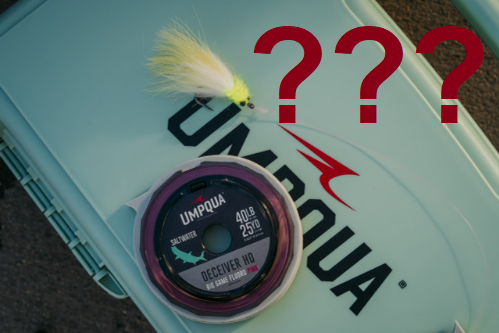Pink Tippet?
Comparing Pink Fluorocarbon Tippet vs Clear

July 2023
Do you ever see or hear something that raises red flags? Something that compels you to pull out your BS meter and push back on odd claims? Recently, the BS meter alarm chirped again. This time about pink tippet, (checks notes), yes pink tippet... So, let's compare compare pink fluorocarbon tippet vs clear fluorocarbon tippet.
Umpqua's Deceiver HD Big Game Fluorocarbon Tippet-Pink

So the obvious red flag is why the hell would pink make for better tippet in big game tarpon? Umpqua claims that this tippet;
"offers all the advantages of a premium fluorocarbon but goes a step beyond when it comes to sub surface invisibility. Red is the first color in the water column to disappear and pink is the lightest shade of red making it fall out the quickest".
Plus this detail;
In addition, when standard fluorocarbon gets abraded or nicked the defect illuminates clearly underwater, the unique pink additive greatly reduces this problem adding to the invisibility.
They further go on to say that these features have "Zero Downsides - compared to standard Fluorocarbon" and is geared for anglers "looking for the extra 2-5% difference".
So let's look at this pink tippet more closely
Ok so they are correct that Red does indeed filter out quickest in water. We explore this topic in a related article, but to reiterate: Light on the red side of the spectrum has longer wavelengths than light on the blue side of the spectrum. In terms of what our eyes see, Red will filter out quickest in water. But what does that mean? Claims that this light filters out doesn't mean that it simply vanishes and goes away. If you drop a red colored rod in the water, as the rod sinks to the bottom of the ocean, that red rod slowly starts to look brown then black, deeper and deeper. So red loses its color as you go deeper, but lack of color doesn’t mean clear. It means gray and black. So it’s like a darker shade of fluoro.

But I think there is a little more going on here. Fluorocarbon has the same light refractive index as water, that is kind of the point. Translucent fluoro mimics light in the same way as water. But this can be problematic as well. When tippet gets shredded up from big ol' tarpon mouths, clear tippet loses it's translucence where nicks have disrupted the internal structure of the tippet exposing white eroded areas across your line. This is because fluoro is kind of like fiber-optic cables, light transmits well, so any light on any section can be transmit to new areas. If those new areas are scored and chaffed, the light makes the nicks highly apparent. But what would happen with pink tippet? The red wavelengths within pink fluoro would emit longer wavelength light and likely mask the visual effects of nicked line, and even dampens the reflection from sunlight.
Nothing compares to actual experimental evidence. This video speaks for itself, pink sure looks to have some stealth benefits. But remember the context for how this marketed, towards tarpon... a fish that tends to eat upwards. In this experiment, when looking up towards the surface (following the path of a tarpon chasing a fly), the hardest lines to see were clear and tinted green. Tinted pink seemed to perform best against deeper water backdrops.
Umpqua also makes some weird claims, like a "2-5% difference" in performance compared to translucent fluoro.
Why throw statistics into the mix without any clarification. Do I think they actually somehow compared transparent vs pink and discovered a measurable 2-5% difference in performance? First of all, 2-5% difference isn't catching any eyes. Hey everyone, this new weight-loss pill drops your weight by 2-5%. That's not a convincing sales pitch. So what is the point of this claim? Well I think it's a lazy attempt to grab all the hardcore anglers looking for any tiny edge. But why attach such specific values to this claim? See: the Fake Precision Fallacy.
Some details about the physical science justifying this pink tippet would have been such a stronger sales point than their dubious justification. But that's nowhere to be found. So is the underwater footage enough evidence? Is pink legit? Nothing speaks like actual experimental evidence, so why am I still slightly skeptical of Umpqua's assertions?
We reached out to Umpqua to clarify their claims, and all they could share was a regurgitation of the same details as mentioned above. So even though there might be some situations (in the wide universe of fishing) where pink maybe does make sense, why won't my BS meter sending off red flags?
One Question Remains:
Are fish actually tippet shy to this level of detail? Nylon worked before fluoro, and standard fluoro has worked up until pink. So does tippet stealthiness really matter all that much? I'll defer to the saltwater angler.
What do you think, are there applications for freshwater too?
We would truly love to hear from anyone who has tried this tippet or wants to chime in about this enigmatic product.


